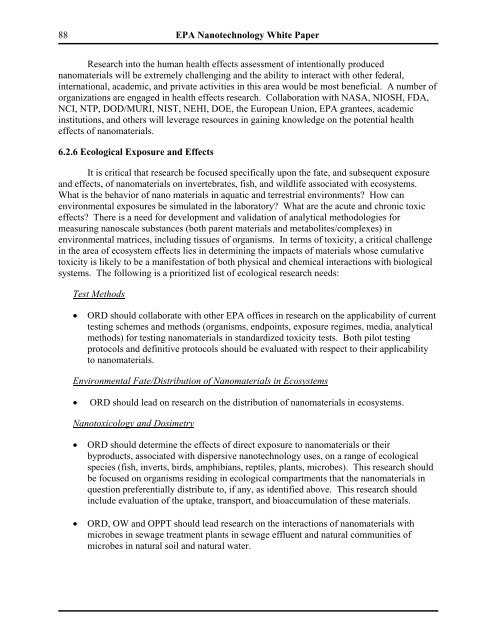Nanotechnology White Paper - US Environmental Protection Agency
Nanotechnology White Paper - US Environmental Protection Agency
Nanotechnology White Paper - US Environmental Protection Agency
You also want an ePaper? Increase the reach of your titles
YUMPU automatically turns print PDFs into web optimized ePapers that Google loves.
88 EPA <strong>Nanotechnology</strong> <strong>White</strong> <strong>Paper</strong><br />
Research into the human health effects assessment of intentionally produced<br />
nanomaterials will be extremely challenging and the ability to interact with other federal,<br />
international, academic, and private activities in this area would be most beneficial. A number of<br />
organizations are engaged in health effects research. Collaboration with NASA, NIOSH, FDA,<br />
NCI, NTP, DOD/MURI, NIST, NEHI, DOE, the European Union, EPA grantees, academic<br />
institutions, and others will leverage resources in gaining knowledge on the potential health<br />
effects of nanomaterials.<br />
6.2.6 Ecological Exposure and Effects<br />
It is critical that research be focused specifically upon the fate, and subsequent exposure<br />
and effects, of nanomaterials on invertebrates, fish, and wildlife associated with ecosystems.<br />
What is the behavior of nano materials in aquatic and terrestrial environments? How can<br />
environmental exposures be simulated in the laboratory? What are the acute and chronic toxic<br />
effects? There is a need for development and validation of analytical methodologies for<br />
measuring nanoscale substances (both parent materials and metabolites/complexes) in<br />
environmental matrices, including tissues of organisms. In terms of toxicity, a critical challenge<br />
in the area of ecosystem effects lies in determining the impacts of materials whose cumulative<br />
toxicity is likely to be a manifestation of both physical and chemical interactions with biological<br />
systems. The following is a prioritized list of ecological research needs:<br />
Test Methods<br />
• ORD should collaborate with other EPA offices in research on the applicability of current<br />
testing schemes and methods (organisms, endpoints, exposure regimes, media, analytical<br />
methods) for testing nanomaterials in standardized toxicity tests. Both pilot testing<br />
protocols and definitive protocols should be evaluated with respect to their applicability<br />
to nanomaterials.<br />
<strong>Environmental</strong> Fate/Distribution of Nanomaterials in Ecosystems<br />
• ORD should lead on research on the distribution of nanomaterials in ecosystems.<br />
Nanotoxicology and Dosimetry<br />
• ORD should determine the effects of direct exposure to nanomaterials or their<br />
byproducts, associated with dispersive nanotechnology uses, on a range of ecological<br />
species (fish, inverts, birds, amphibians, reptiles, plants, microbes). This research should<br />
be focused on organisms residing in ecological compartments that the nanomaterials in<br />
question preferentially distribute to, if any, as identified above. This research should<br />
include evaluation of the uptake, transport, and bioaccumulation of these materials.<br />
• ORD, OW and OPPT should lead research on the interactions of nanomaterials with<br />
microbes in sewage treatment plants in sewage effluent and natural communities of<br />
microbes in natural soil and natural water.

















